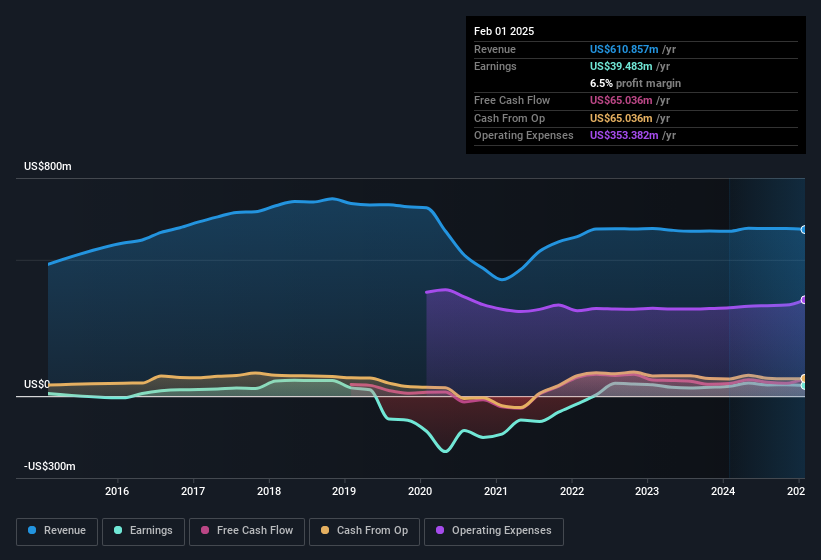Statutory Profit Doesn't Reflect How Good J.Jill's (NYSE:JILL) Earnings Are
The subdued stock price reaction suggests that J.Jill, Inc.'s (NYSE:JILL) strong earnings didn't offer any surprises. Investors are probably missing some underlying factors which are encouraging for the future of the company.

Zooming In On J.Jill's Earnings
One key financial ratio used to measure how well a company converts its profit to free cash flow (FCF) is the accrual ratio. In plain english, this ratio subtracts FCF from net profit, and divides that number by the company's average operating assets over that period. You could think of the accrual ratio from cashflow as the 'non-FCF profit ratio'.
As a result, a negative accrual ratio is a positive for the company, and a positive accrual ratio is a negative. While having an accrual ratio above zero is of little concern, we do think it's worth noting when a company has a relatively high accrual ratio. Notably, there is some academic evidence that suggests that a high accrual ratio is a bad sign for near-term profits, generally speaking.
J.Jill has an accrual ratio of -0.19 for the year to February 2025. That indicates that its free cash flow quite significantly exceeded its statutory profit. To wit, it produced free cash flow of US$65m during the period, dwarfing its reported profit of US$39.5m. J.Jill shareholders are no doubt pleased that free cash flow improved over the last twelve months. Having said that, there is more to consider. We must also consider the impact of unusual items on statutory profit (and thus the accrual ratio), as well as note the ramifications of the company issuing new shares.
Check out our latest analysis for J.Jill
That might leave you wondering what analysts are forecasting in terms of future profitability. Luckily, you can click here to see an interactive graph depicting future profitability, based on their estimates.
To understand the value of a company's earnings growth, it is imperative to consider any dilution of shareholders' interests. In fact, J.Jill increased the number of shares on issue by 44% over the last twelve months by issuing new shares. Therefore, each share now receives a smaller portion of profit. To celebrate net income while ignoring dilution is like rejoicing because you have a single slice of a larger pizza, but ignoring the fact that the pizza is now cut into many more slices. Check out J.Jill's historical EPS growth by clicking on this link.
How Is Dilution Impacting J.Jill's Earnings Per Share (EPS)?
Three years ago, J.Jill lost money. The good news is that profit was up 9.3% in the last twelve months. But EPS was less impressive, up only 3.3% in that time. Therefore, one can observe that the dilution is having a fairly profound effect on shareholder returns.
In the long term, earnings per share growth should beget share price growth. So it will certainly be a positive for shareholders if J.Jill can grow EPS persistently. However, if its profit increases while its earnings per share stay flat (or even fall) then shareholders might not see much benefit. For the ordinary retail shareholder, EPS is a great measure to check your hypothetical "share" of the company's profit.
The Impact Of Unusual Items On Profit
J.Jill's profit was reduced by unusual items worth US$9.3m in the last twelve months, and this helped it produce high cash conversion, as reflected by its unusual items. This is what you'd expect to see where a company has a non-cash charge reducing paper profits. While deductions due to unusual items are disappointing in the first instance, there is a silver lining. When we analysed the vast majority of listed companies worldwide, we found that significant unusual items are often not repeated. And, after all, that's exactly what the accounting terminology implies. If J.Jill doesn't see those unusual expenses repeat, then all else being equal we'd expect its profit to increase over the coming year.
Our Take On J.Jill's Profit Performance
In conclusion, both J.Jill's accrual ratio and its unusual items suggest that its statutory earnings are probably reasonably conservative, but the dilution means that per-share performance is weaker than the statutory profit numbers imply. Looking at all these factors, we'd say that J.Jill's underlying earnings power is at least as good as the statutory numbers would make it seem. Keep in mind, when it comes to analysing a stock it's worth noting the risks involved. Be aware that J.Jill is showing 2 warning signs in our investment analysis and 1 of those doesn't sit too well with us...
After our examination into the nature of J.Jill's profit, we've come away optimistic for the company. But there are plenty of other ways to inform your opinion of a company. For example, many people consider a high return on equity as an indication of favorable business economics, while others like to 'follow the money' and search out stocks that insiders are buying. So you may wish to see this free collection of companies boasting high return on equity, or this list of stocks with high insider ownership.
Have feedback on this article? Concerned about the content? Get in touch with us directly. Alternatively, email editorial-team (at) simplywallst.com.
This article by Simply Wall St is general in nature. We provide commentary based on historical data and analyst forecasts only using an unbiased methodology and our articles are not intended to be financial advice. It does not constitute a recommendation to buy or sell any stock, and does not take account of your objectives, or your financial situation. We aim to bring you long-term focused analysis driven by fundamental data. Note that our analysis may not factor in the latest price-sensitive company announcements or qualitative material. Simply Wall St has no position in any stocks mentioned.
 Wall Street Journal
Wall Street Journal